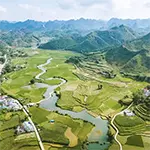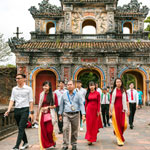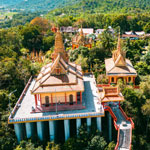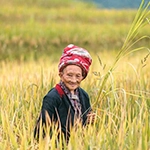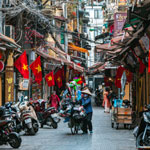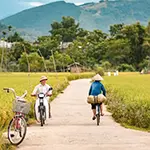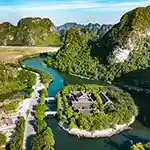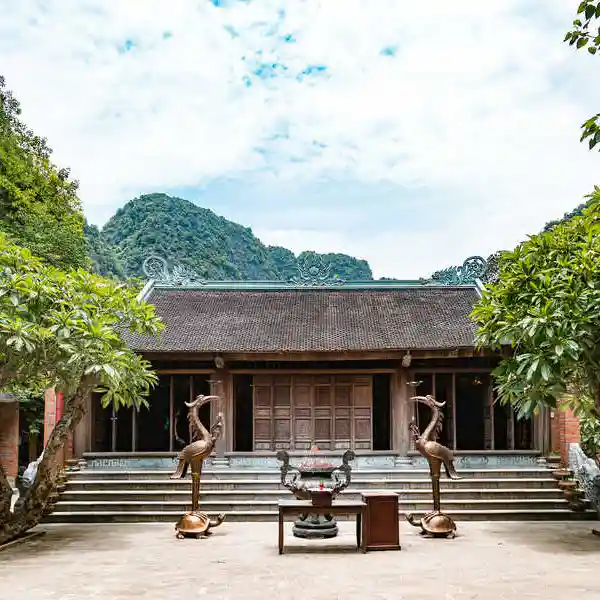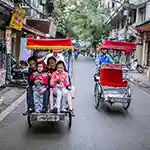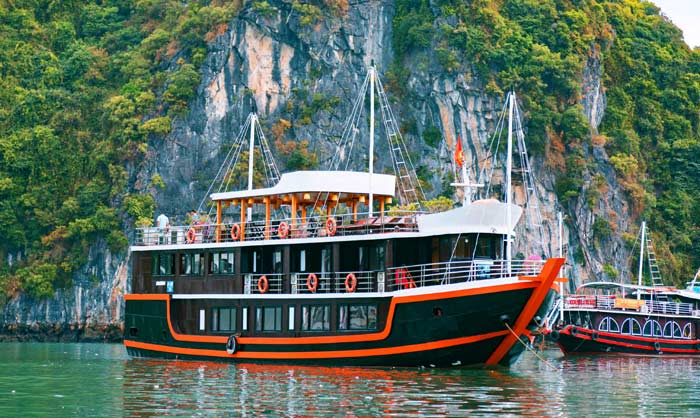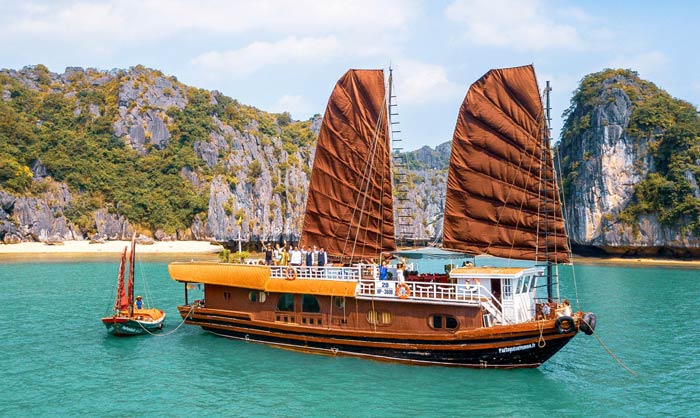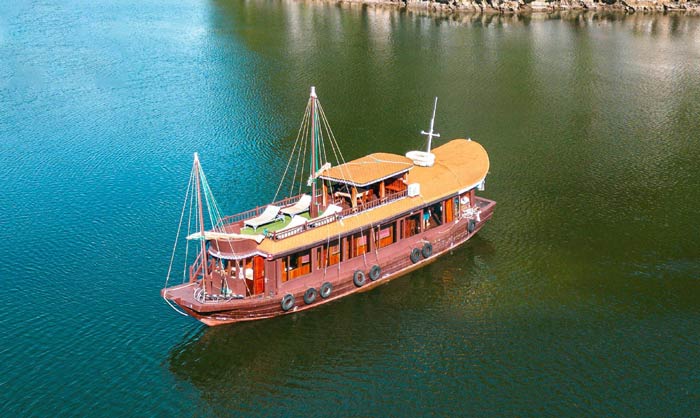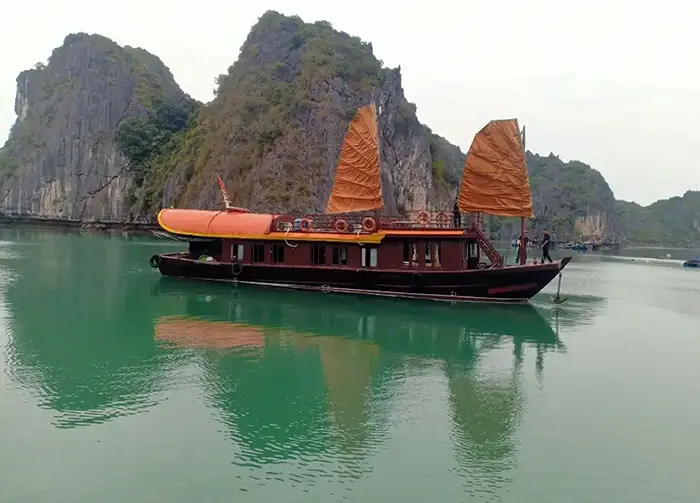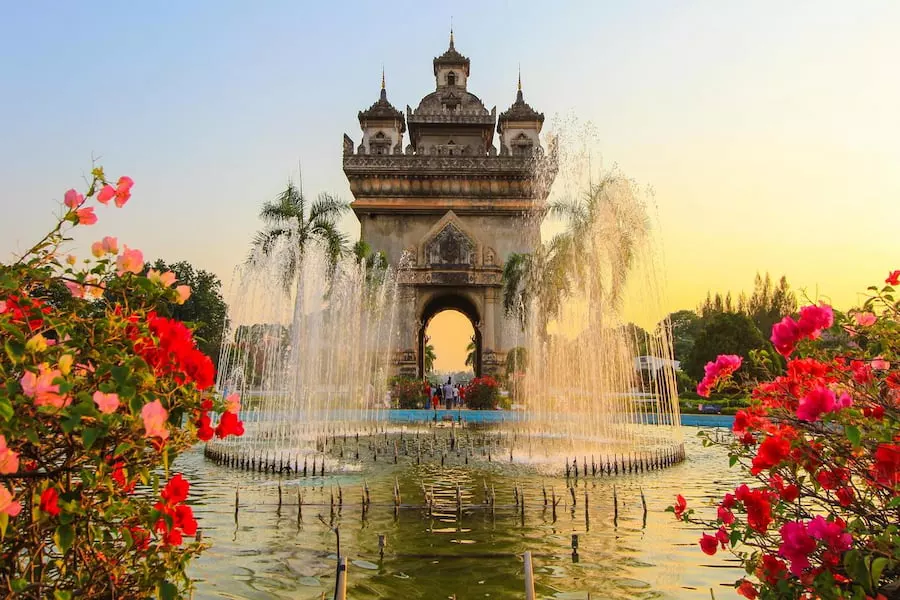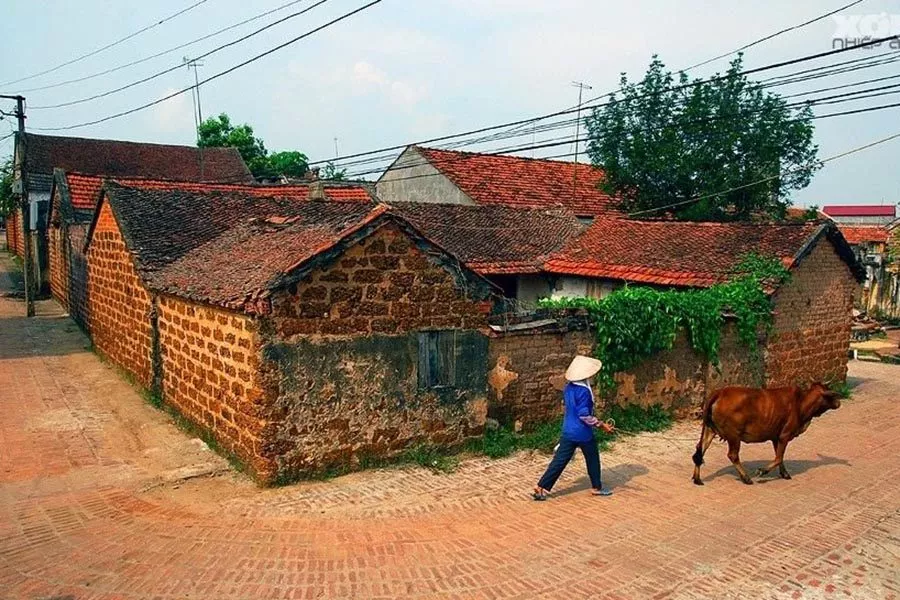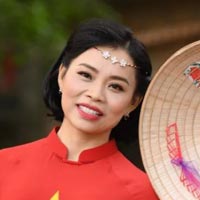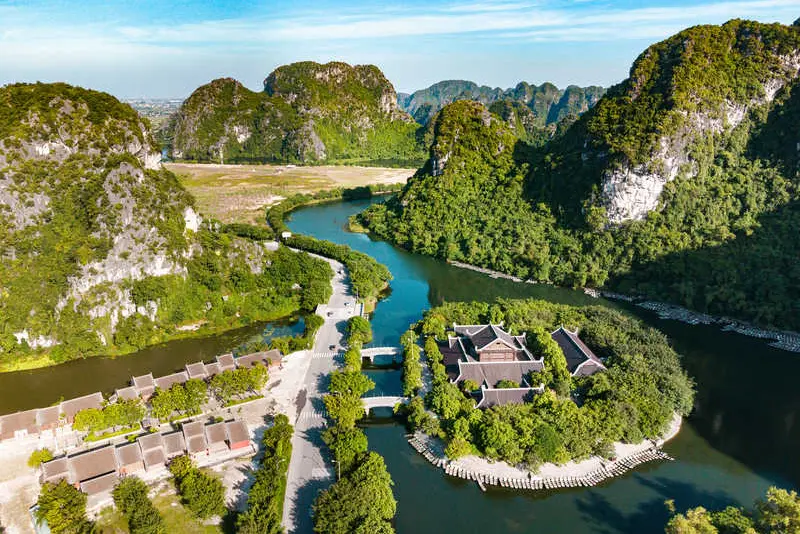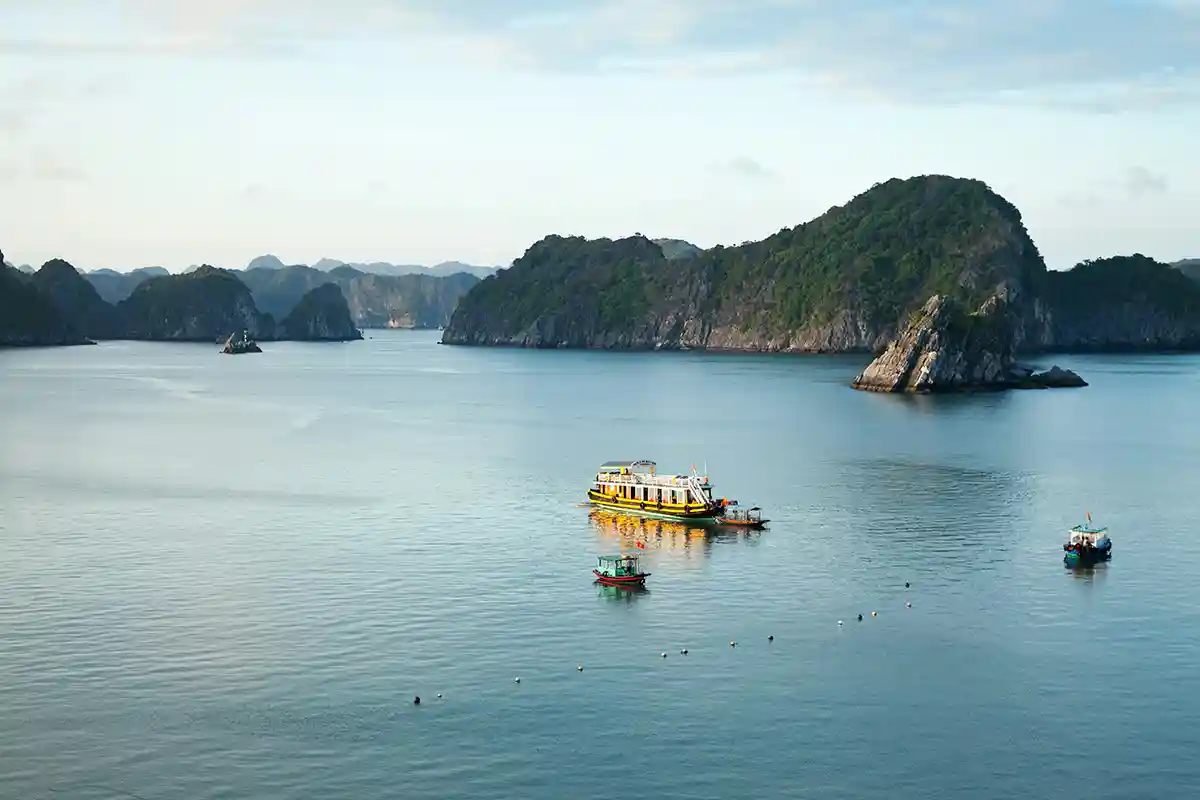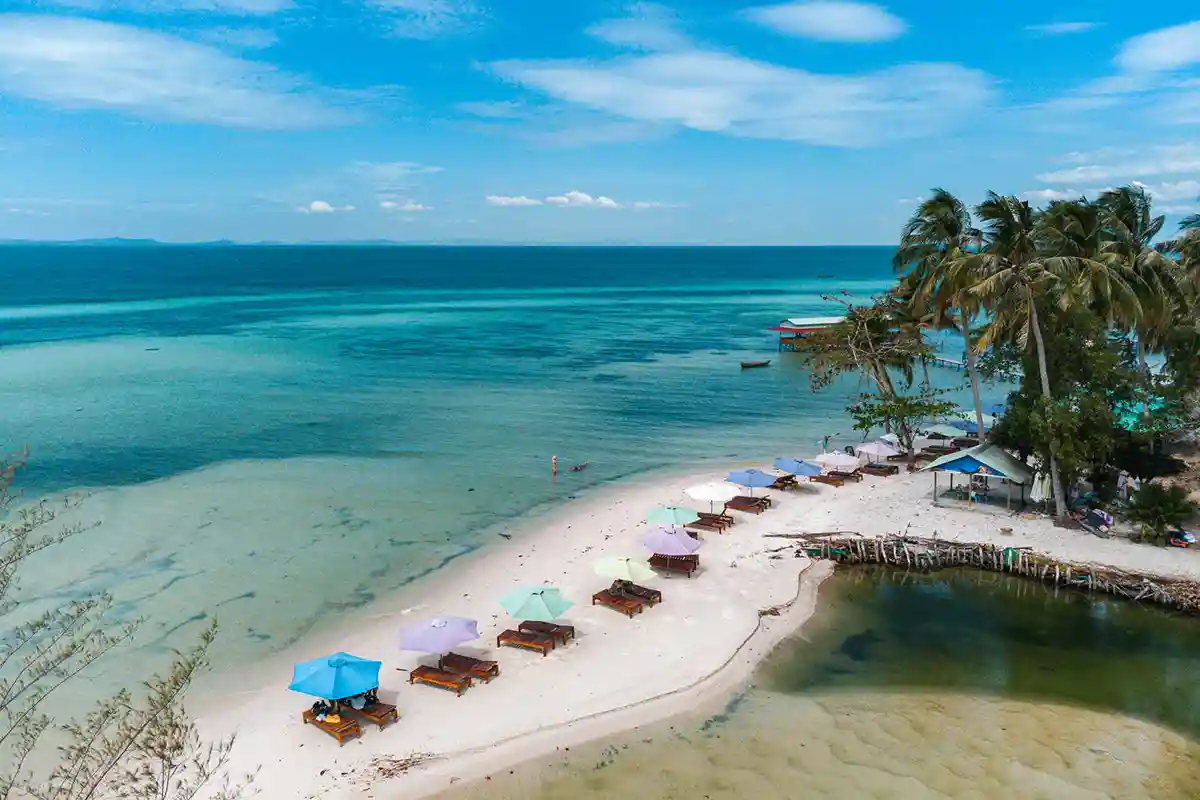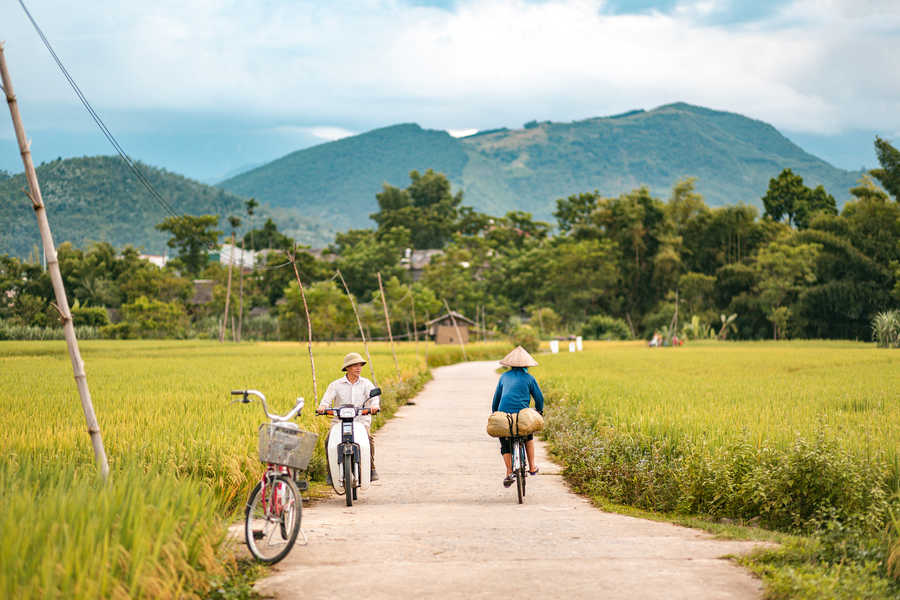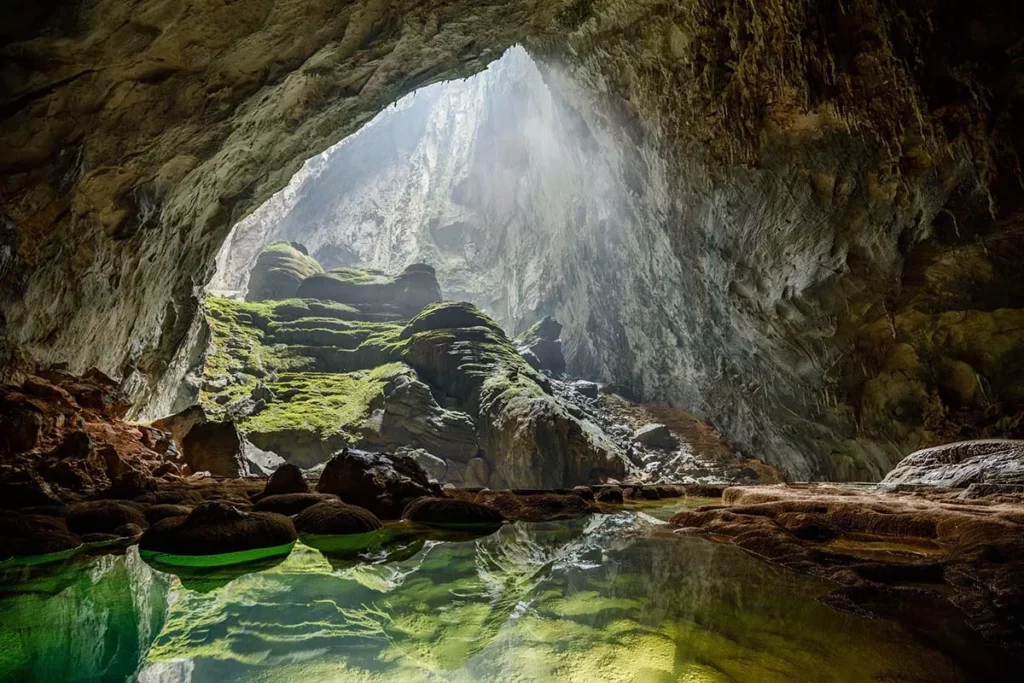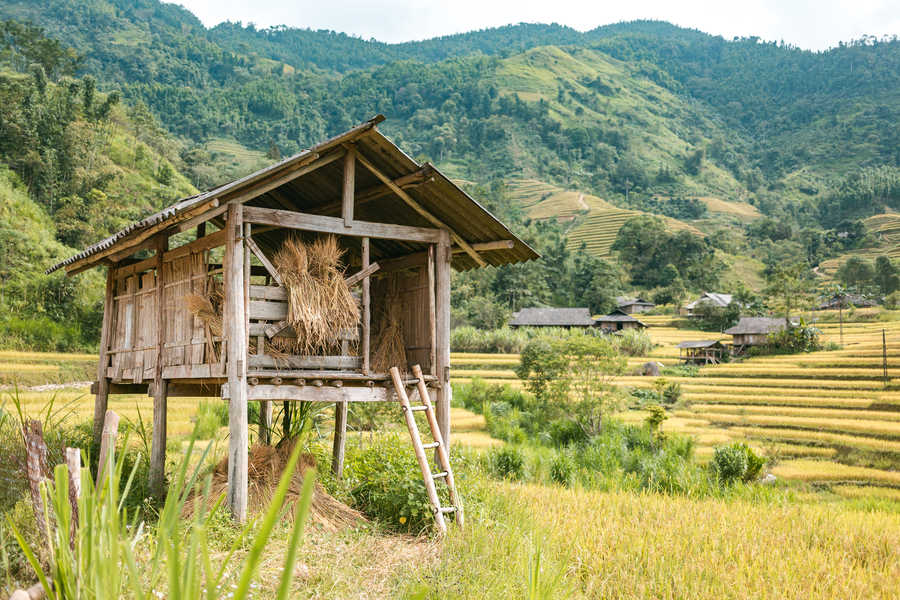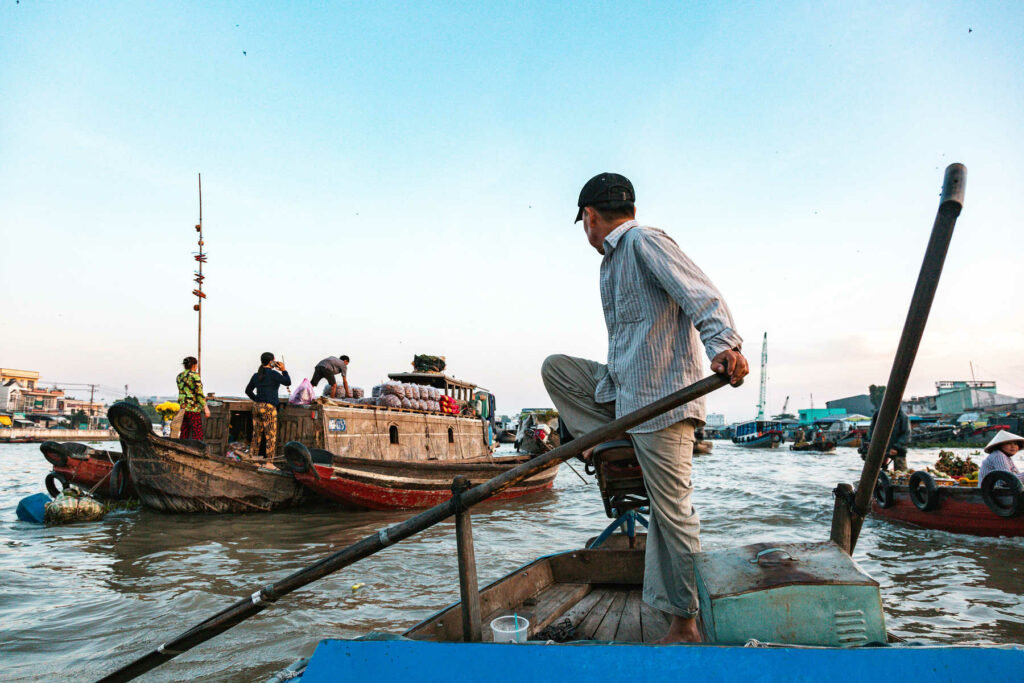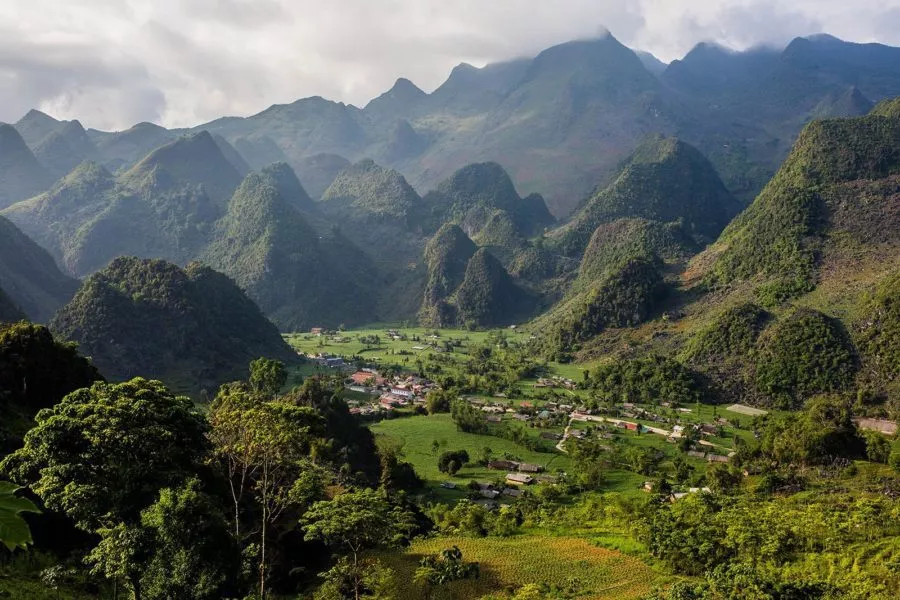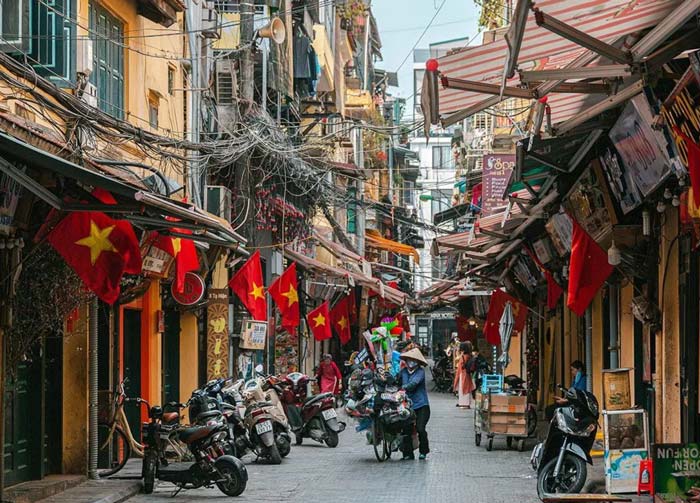Located along the Mekong River, Vientiane, the capital of Laos, is a captivating city where Buddhist serenity meets colonial charm. This destination offers a perfect blend of ancient temples, historical monuments, and lively markets, all wrapped in a peaceful atmosphere unique to Southeast Asia. Famous for landmarks such as Pha That Luang and Patuxai, it also invites visitors to enjoy authentic Lao cuisine.
In this article, discover the best time to explore Vientiane, its must-see cultural treasures, and the local culinary specialties you shouldn’t miss. An unforgettable adventure awaits you in the heart of this little-known and fascinating capital.
Introduction to Vientiane
The name Vientiane originates from Pali, the literary language of Theravada Buddhism, and originally meant “The King’s Sandalwood Forest,” in reference to this precious tree celebrated in Indian texts for its enchanting fragrance. In Lao, Vientiane means “The City of the Moon,” evoking the peaceful and poetic charm of the capital. Located on the left bank of the Mekong River, Vientiane is bordered by Vientiane Province to the northwest and north, Bolikhamsai to the northeast, the Thai provinces of Nong Khai and Bueng Kan to the south, and the Mekong to the east.
Covering an area of about 3,920 km² and home to an estimated 820,940 inhabitants, Vientiane offers a delightful setting. A stroll along the Mekong is a must—perfect for wandering, enjoying its quaint cafés and restaurants, or exploring the lively night market.
Among its iconic landmarks are Patuxai, a majestic triumphal arch, and Wat Sisaket, the city’s most sacred and oldest Buddhist temple. About 25 km from the city center, the Buddha Park, with its more than 200 unique statues, is an ideal destination for a spiritual and cultural getaway.
Although Vientiane is not yet a major tourist hotspot, it easily enchants visitors with the authenticity and warmth of its people, the beauty of its ancient temples, its millennia-old historical monuments, its wild mountain landscapes, and its majestic waterfalls—leaving an unforgettable impression.
Best time to visit Vientiane
Laos has a tropical monsoon climate with two clearly distinct seasons. The rainy season lasts from May to November, with an average temperature of around 30°C, characterized by high humidity and frequent showers. In contrast, the dry season runs from December to April, with temperatures ranging between 15°C and 25°C, offering dry, pleasant weather—ideal conditions for visiting the capital, Vientiane. During this period, the city takes on a calm and enjoyable atmosphere, perfect for exploring.
Besides the weather, you may also choose to visit Vientiane during the country’s major traditional festivals, which offer a unique cultural experience. Significant events such as Lunar New Year (in January, similar to Vietnam’s Tết celebrations), Lao New Year (in April), and the H’Mong New Year (from late November, typically from November 30 to December 5 depending on the lunar calendar) are wonderful opportunities to discover local customs and traditional ceremonies.
Vientiane is also enlivened by other traditional celebrations, such as Buddha Day (in April), which honors the Buddha’s birthday through prayers and rituals. The month of fasting (in July) offers a serene and peaceful experience, with the city immersed in a calm, spiritual ambiance. Finally, the Boat Racing Festival in October, featuring energetic competitions on the Mekong, is a popular event that draws thousands of locals and visitors.
These celebrations allow you to immerse yourself in the festive atmosphere of Vientiane and enrich your trip with deep, memorable cultural experiences.
How to get to Vientiane
Upon arrival at Wattay International Airport, several transportation options are available to reach the center of Vientiane, located about 5 km away.
If you are traveling in a group of 3 to 4 people, taking a taxi is a convenient option, with fares ranging from 57,000 to 66,000 Kip depending on the distance to your hotel.
For those traveling alone or as a couple, the bus is an economical solution, costing only 15,000 Kip per ride. However, it is important to know in advance the bus stop closest to your hotel to make your journey easier.
Tuk-tuks, very popular and comfortable in Vientiane, are another option, with an average fare of around 20,000 Kip per trip, and you can easily negotiate the price with the driver. Lastly, pickups are also widely used, offering both flexibility and reasonable rates. You can rent a pickup from one of the agencies in the city or choose a taxi or private vehicle to reach the city center quickly and comfortably.
Best sites to visit in Vientiane
Patuxai arch of triumph
Patuxai, also known as the “Victory Gate,” is one of the most iconic landmarks in Vientiane, the capital of Laos. This architectural masterpiece, located in the heart of the city’s main avenue, immediately catches the eye with its imposing and majestic presence, even from a distance. Built in 1960, Patuxai was erected to honor the Lao soldiers who sacrificed their lives in the conflicts that marked the country’s struggle for independence and freedom. The monument stands not only as an impressive architectural work, but also as a powerful reminder of the history and patriotism of the Lao people.
Although its silhouette may evoke the Arc de Triomphe in Paris, Patuxai is deeply rooted in Lao cultural and artistic identity. The monument features four monumental arches on each of its sides, arranged in perfect symmetry. The ceilings above the vaults are adorned with intricate carvings and frescoes depicting Buddhist and Hindu deities such as Vishnu and Brahma, as well as mythological Lao figures like the three-headed elephant Erawan and the kinnaree, a half-human, half-bird celestial being. These decorative details highlight the cultural and spiritual richness of Laos, giving visitors a visually striking and culturally immersive experience.
Patuxai is composed of seven levels, all connected by spiral staircases that allow visitors to ascend gradually while discovering the interior structure and the historical displays along the way. Each floor offers a different vantage point over the city. At the top, a panoramic viewing platform provides an incredible view of Vientiane: its ancient temples, modern buildings, and the Mekong River winding peacefully in the distance. It is the perfect spot to appreciate the serene beauty of the city while feeling the weight of its history.
The monument also serves as a gathering place for locals, especially in the late afternoon. At this time of day, Patuxai is bathed in the golden glow of the setting sun, creating an almost magical atmosphere. Families, friends, and local sports groups meet here to dance, exercise, or simply relax. This lively yet peaceful ambience perfectly reflects the warm and welcoming spirit of Lao culture.
With its impressive structure, rich history, and central role in local life, Patuxai is far more than just a monument. It is a symbol of national pride and a memorable stop for visitors. Whether you are passionate about history, fascinated by architecture, or simply looking for a unique viewpoint over the city, a visit to Patuxai is an essential experience during your stay in Vientiane.
Wat Sisaket
Wat Sisaket, a hidden gem in the heart of Vientiane, is a must-visit for anyone wishing to discover the historical and cultural richness of Laos. This exceptional temple houses an impressive collection of 6,840 Buddha statues, crafted from a variety of materials such as bronze, wood, silver, plaster, and fine gold. Each statue is a unique work of art, reflecting the evolution of Lao sculpture from the 16th to the 19th century. Every figure tells its own story, embodying centuries of devotion, tradition, and cultural heritage.
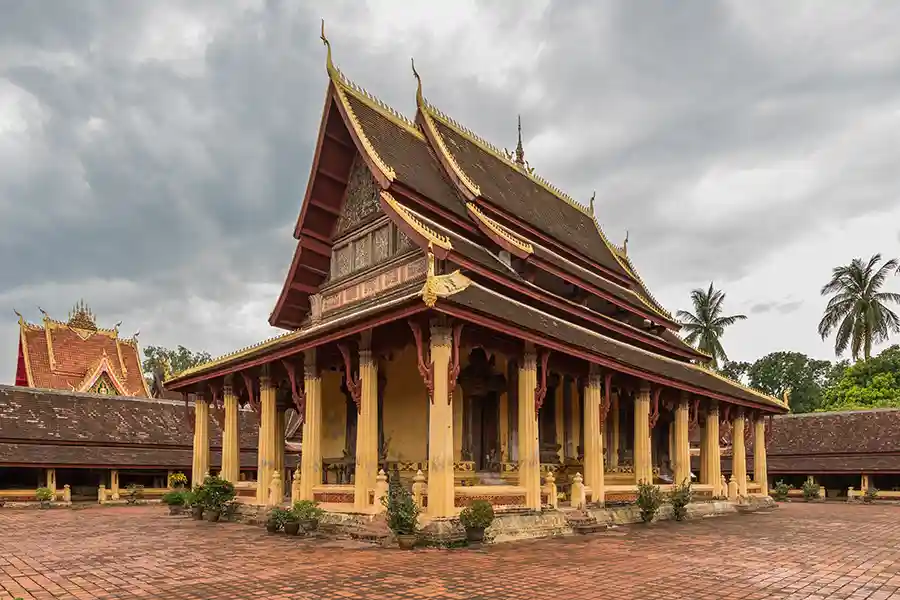
Wat Sisaket temple
The architecture of Wat Sisaket is a true masterpiece. Its five-tiered roof and intricate details give the temple a sense of majesty and serenity that immediately captivates visitors. Surrounding the main sanctuary, a long corridor houses more than 2,000 Buddha statues, meticulously carved from materials such as wood, stone, and tin. These statues, both simple and refined, illustrate the evolution of Lao sculpture through the ages. The western corridor is particularly moving, displaying broken statues that survived the Siamese military attacks of 1828. Although many have lost their heads, arms, or legs, they still emanate a powerful symbolic presence, representing resilience and the memory of a tumultuous past.
One of the most fascinating features of Wat Sisaket is its “Buddha statue reservoir,” located to the left of the temple. Behind a simple wooden door, you will find a multitude of statues, both large and small, some of them incomplete—with intact bodies but missing heads, arms, or legs. This unique collection, marked by the absence of heads on every statue, gives the space a distinctive spiritual and historical aura, inviting visitors to reflect on time, loss, and endurance.
Beyond its remarkable statues, Wat Sisaket is also a sanctuary of knowledge. It houses a precious library containing more than 8,000 ancient Buddhist manuscripts, handwritten on palm leaves. These works, nearly 400 years old, are a true treasure of wisdom, chronicling the development of Buddhism and Lao spirituality over the centuries. Inside the sanctuary, thousands of small niches each hold a Buddha statue, creating an atmosphere of spiritual protection and serenity for devotees who come to meditate. These statues, more than simple artworks, are living witnesses to the deeply rooted faith of the Lao people.
The temple is surrounded by galleries that display hundreds more Buddha statues, in a wide variety of styles and sizes. Each one contributes to the solemn and peaceful atmosphere of the site, allowing visitors to reconnect with a spiritual dimension and escape the noise of everyday life.
Visiting Wat Sisaket is an immersion into the soul of Laos. It is a journey through time, a moment of calm and meditation where art, history, and spirituality come together to offer an unforgettable experience. This temple is far more than a monument—it is a place of reflection, serenity, and reverence, a true cultural treasure of Southeast Asia
Pha That Luang
That Luang, or the “Great Sacred Stupa”, is undoubtedly one of Laos’ most precious treasures—an enduring symbol of the nation’s culture and spirituality. This revered sanctuary, deeply respected and cherished by the Lao people, embodies both the history and the faith of the country. With its imposing architecture and timeless charm, it rises majestically as the spiritual heart of Laos, attracting visitors from around the world thanks to its profound cultural and religious significance.
Its official name, Chedi Loka Chunlamani, which translates to “The World Jade Stupa,” pays tribute to its grandeur. However, locals prefer to call it simply That Luang, a name that highlights the monument’s magnificence and its central role in the spiritual and historical life of the Lao people. Located just 3 kilometers north of central Vientiane, it stands as a perfect example of traditional Lao architecture. Seen from a distance, the stupa resembles a wine jar, a symbol of spiritual abundance and prosperity that resonates deeply with the soul.
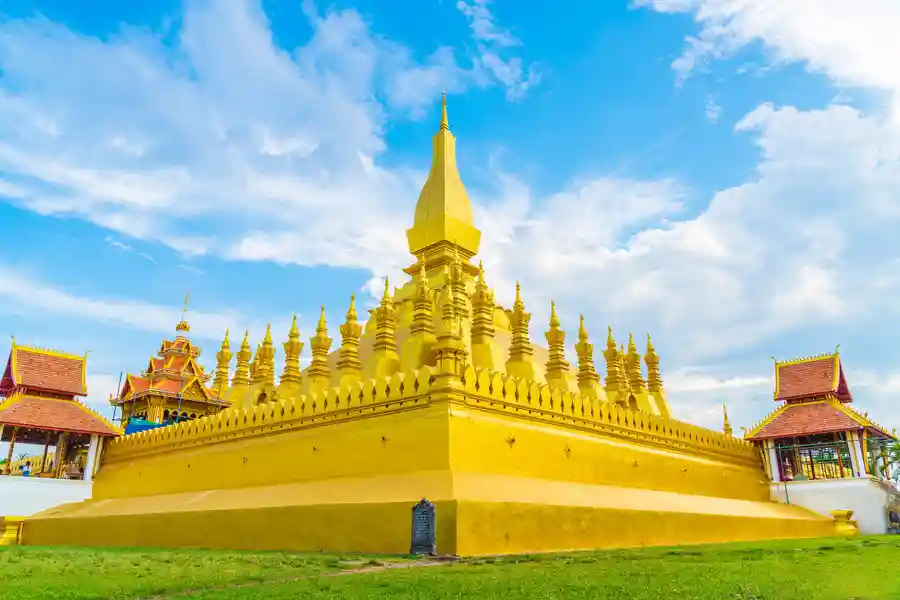
That Luang, or “Great Sacred Stupa“
Erected in 1566 on the ruins of an older temple, That Luang has endured the centuries, overcoming numerous challenges, including wars with Thailand. Although the stupa suffered significant damage, particularly in the 19th century, it was restored and continues to shine, proudly withstanding the test of time. Today, after more than 450 years, it remains a living testament to the history of Laos and the Lao people’s determination to preserve and honor their heritage.
The central stupa, standing 45 meters tall, rises majestically, surrounded by golden pillars that glitter in the sunlight. At its base, a meticulously carved lotus flower symbolizes purity and spiritual awakening. Covering an area of 90 square meters, this imposing monument is a true architectural masterpiece. From afar, That Luang resembles a giant lotus supporting a sacred treasure, and its top, shaped like a square gourd, represents spiritual elevation—a visible link between heaven and earth, symbolizing both the origins of the universe and the soul of the Lao people.
The stairways leading to the stupa’s summit hold deep significance. Each level represents a stage of Buddhist enlightenment. The uppermost level, symbolizing the horizon of spiritual void, contrasts with the lower level, which represents the material world. These stairways are not merely architectural features; they also serve as a symbolic guide for those seeking a spiritual journey and inner elevation—a path through the principles of Buddhist faith.
Visiting That Luang is a full immersion into the soul of Laos, a place where culture, faith, and history intertwine harmoniously. It is a space where one can feel profound inner peace, take a moment to reconnect with oneself, and meditate on life’s essential values. That Luang is not just an architectural monument; it is a living symbol of the resilience, wisdom, and dignity of the Lao people—a national treasure that continues to shine through the centuries and inspire the soul.
Wat Phra Keo
Le Wat Phra Keo, également connu sous le nom de Ho Phra Keo ou Ho Phakeo, est l’un des temples les plus célèbres de Vientiane. Ce temple a été construit en 1565 par le roi Setthathirat, dans le but de protéger la précieuse statue du Bouddha d’Émeraude. Cette statue a une histoire fascinante qui est intimement liée à celle du Laos. Après la mort de son père, le roi Phothisarat, le roi Setthathirat, qui régnait sur le royaume de Lanna (aujourd’hui Chiang Mai), a dû quitter son territoire pour retourner à Vientiane, emportant la statue du Bouddha d’Émeraude avec lui.
However, in 1779, when Thai troops led by General Chakri (who would later become King Rama I) attacked Vientiane, they looted the temple and took the Emerald Buddha statue, placing it in Wat Phra Kaew in Bangkok. This was a great loss for Laos. The Lao people later restored the temple, but it was destroyed again during another Thai attack in 1828. After this incident, the Thai king, himself a devout Buddhist, commissioned a new Emerald Buddha statue, identical to the original, and sent it back to Laos. This statue now occupies the place of the one that had been taken.
Today, Wat Phra Keo is much more than a place of worship. It houses a true museum where visitors can discover numerous precious Buddhist artworks. The temple contains Buddha statues carved from various materials such as bronze, stone, and clay, each with remarkable beauty and fine details that showcase the excellence of Lao craftsmanship. In addition to the statues, the temple also preserves objects made of gold, silver, and jade, reflecting the rich cultural and spiritual heritage of Laos.
The temple’s architecture is simply impressive. Built on a solid stone base, its walls, columns, and ceilings are adorned with finely carved decorations. As you ascend the stairs, you will notice dragons sculpted in stone, adding a symbolic and mystical touch to your visit. The windows and doors are decorated with statues of Apsara goddesses, further enhancing the sacred atmosphere of the site.
Inside, you can admire a wide variety of Buddha statues, each with a unique expression. None are identical, giving the collection a richness and diversity. Some of these statues are covered in gold, particularly on the head, chest, and abdomen, symbolizing reverence and spiritual protection. These statues are not only beautiful works of art but also symbols of blessing, offering peace and happiness to the Lao people.
Wat Phra Keo is therefore an unmissable place to visit in Vientiane. It is not only a place of worship but also a treasure of history and art, where visitors can learn more about Buddhist culture and Lao heritage. It is a peaceful and inspiring location, ideal for taking a moment of reflection and connecting with the Lao culture.
The night market
Leaving the temples behind, we come to the night market of Vientiane, located in Chao Anouvong Park and stretching over approximately 300 meters. On one side, it borders the Mekong River, and on the other, Rue Pangkham. The market has an open and airy atmosphere, with well-organized stalls covered by distinctive red fabric. As you explore, you will find a wide variety of products, including clothing, food, artworks, souvenirs, and traditional handicrafts.
Le secteur des souvenirs constitue le cœur du marché. Les étals sont disposés sous forme de longues tentes, quatre rangées en tout, avec les deux rangées centrales appuyées l’une contre l’autre, et les deux rangées latérales tournées vers les maisons environnantes. Les allées larges permettent une circulation fluide et offrent une expérience agréable de shopping.
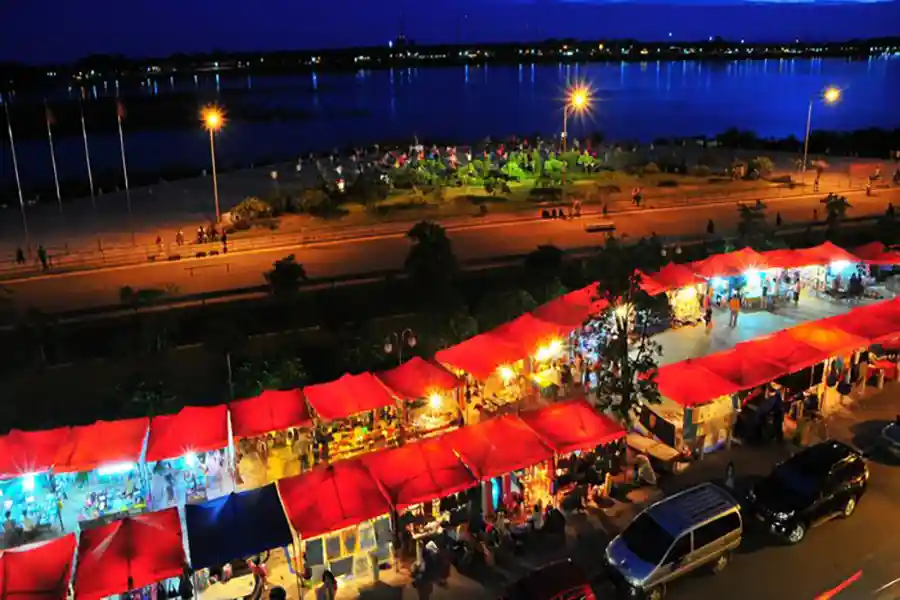
The night market of Vientiane
The handicrafts sold at this market reflect the finesse of traditional Laotian workmanship, particularly in sculpture and weaving, specialties of the Bo Xieng and Pha Nom ethnic groups, as well as of artisan villages that once produced items for the Laotian Royal Court before 1975.
The available items are varied and include scarves, hats, bags, skirts, and clothing made from materials such as nylon, cotton, linen, and colorful silk. You will also have the chance to admire folk paintings, paper lanterns decorated with dried flowers, and multi-tiered spring lanterns, adding a sparkling and magical touch to the market.
Laotians also use a wide variety of materials to represent iconic symbols of the country, such as Vientiane’s landmarks, ancient temples, or the water festival (Boun Pi Maï), through hand-embroidered and colorful motifs. Among the fashion stalls, you will also find traditional items such as fish traps, rice baskets, and bamboo flutes, which further contribute to the unique atmosphere of Vientiane’s night market.
Culinary specialties of Vientiane
Sticky rice – Khao Niaw
Khao Niaw is a typical and delicious Laotian dish, enjoyed both in daily meals and during special celebrations and ceremonies. Made with glutinous rice cultivated in mountain paddies, the rice has a beautiful slightly pearly white color and a texture that is both sticky and tender, making every bite a delight.
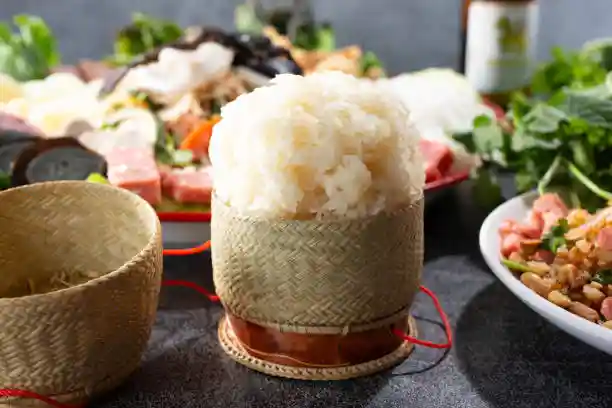
Sticky rice Khao Niaw
The rice is often served in small handwoven bamboo or rattan baskets, a true artisanal tradition of Laos. These baskets keep the rice warm while adding an authentic and charming touch to the culinary experience. Khao Niaw is more than just a dish—it is at the heart of many gatherings, bringing family and friends together to celebrate conviviality and harmony, creating moments of sharing and joy.
Larp or Laap (Laotian minced meat salad)
Laap is an iconic and essential dish of Laotian cuisine, reflecting both culinary finesse and deep cultural significance in the daily life of the Laotian people. This dish is typically prepared with meats such as beef, chicken, pork, duck, or even fish. The ingredients are mixed with fish sauce, spices, lime juice, and aromatic herbs, creating a unique and memorable flavor. Laap can be made with raw or cooked meat, sautéed and mixed with chili, mint, and other fragrant herbs.
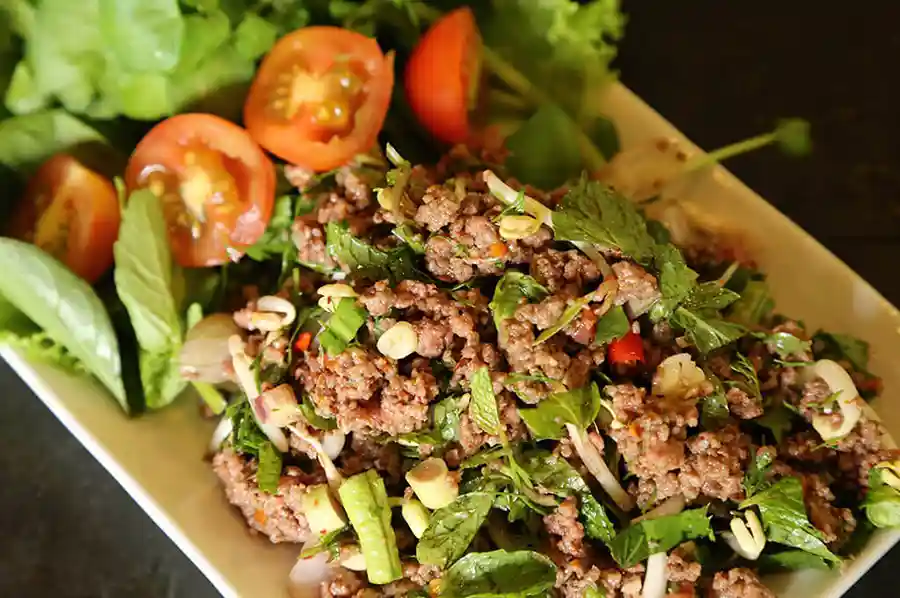
Laotian Larp
Laap is not just a dish; it also holds important cultural significance for the Laotian people. It is prepared with care and attention, expressing gratitude and respect toward the person it is intended for. This tradition is especially strong during the New Year, when Laap is offered as a wish for luck and peace. Laotians believe that if Laap is not prepared carefully, it could bring misfortune to the recipient. Therefore, every step of the preparation is done with great attention.
Although Laap can have many variations, it remains an essential dish during festivals and celebrations, strengthening community bonds and symbolizing unity among people.
Tam Mak Houng (Laotian green papaya salad)
Tam Mak Houng, or papaya salad, is a typical Laotian dish, widely enjoyed in daily meals as well as in street food. This dish is prepared with simple ingredients: papaya, tomatoes, chili, and eggplant, all mixed with a variety of characteristic Laotian spices. Tam Mak Houng is never made in advance; it is always prepared to order. The papaya is chosen so that it is neither too green nor too ripe, ensuring a good crunch and pleasant sweetness. Once peeled, the papaya is shredded into thin strips. The tomatoes and Laotian eggplants are also cut into small pieces. Then garlic, chili, sugar, lime juice, and MSG are crushed together in a mortar to release their aromas.
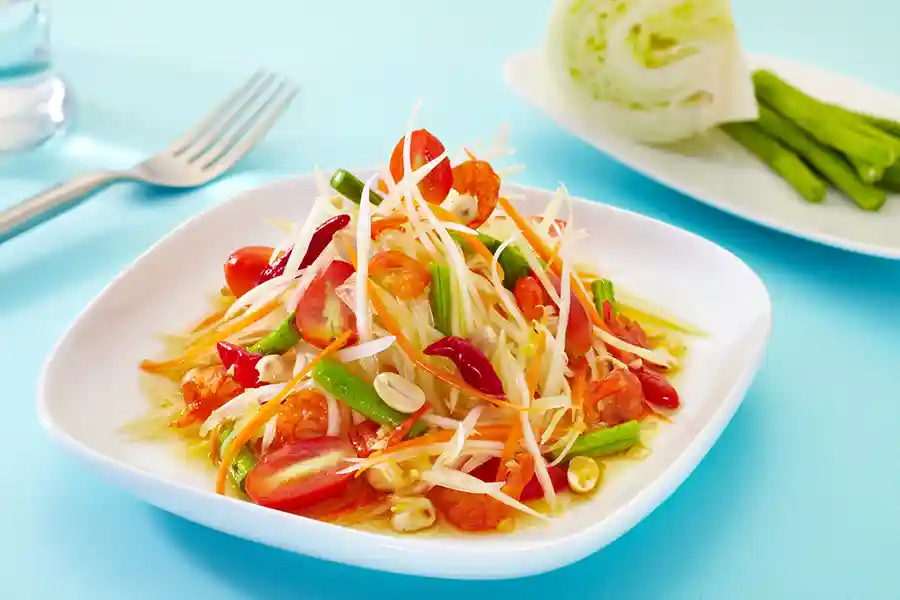
Papaya Salad
The key ingredient of this dish is fish sauce, often fermented fish sauce (Pa Det), which has a strong odor but, when mixed with the other ingredients, releases a unique, delightfully fragrant, and appealing flavor. Finally, coriander and mint are added to bring freshness to the dish. Tam Mak Houng is a simple yet refined dish that perfectly embodies the richness of Laotian cuisine. With its distinct flavors and freshness, it always delights the taste buds of food lovers.
Some tips for your visit to Vientiane
Visiting That Luang
Entrance to That Luang costs 5,000 Kip (approximately €0.46). The temple is open from 8:00 a.m. to 12:00 p.m. and from 1:00 p.m. to 5:00 p.m., except on Mondays. Early morning is the ideal time to visit, as it is cooler and less crowded. You can reach That Luang by taxi, motorcycle, bus, or tuk-tuk, with a tuk-tuk fare of about 60,000 Kip (€5) for 2 to 6 people. Inside, there are many interesting sites to explore, with an additional fee of 10,000 Kip (€0.92) per person for entrance.
Are there specific rules or rituals to follow when visiting That Luang?
Visitors to That Luang should respect certain rules and customs. It is important to show respect at all times. According to the guidelines, before entering the temple buildings or specific areas, visitors must remove their shoes and dress modestly. It is also essential to maintain silence and avoid loud behavior to show respect for this religious site.
Are visitors allowed to take photos at That Luang?
In principle, photography is allowed within That Luang, enabling you to capture the beauty of this sacred place. However, it is crucial to respect local traditions and culture. It is advisable not to photograph people, especially during moments of prayer or religious ceremonies, without their prior consent. These moments are filled with spirituality and intimacy, and it is important not to disturb the serene atmosphere. By showing respect for local customs, you help preserve the harmony of this sacred space.
Visiting the Phra Keo temple
Wat Phra Keo is open every day of the week, from 8:00 a.m. to 12:00 p.m. in the morning and from 1:00 p.m. to 4:00 p.m. in the afternoon. It is a must-visit site for anyone wishing to discover the beauty of Lao architecture and immerse themselves in the country’s history and culture.
To enter the temple, it is important to follow certain dress codes. In particular, women must ensure that their legs are covered, either by wearing long pants or a long skirt. This rule is intended to respect the sacred nature of the site. If you are not wearing appropriate clothing, do not worry. At the temple’s main entrance, you can borrow a sinh lao (traditional Lao sarong) to cover your legs. This is a convenient solution that allows you to visit the temple while respecting local traditions.
Safety in Vientiane
Hotels disclaim all responsibility in the event of loss or theft of personal items, valuables, or money left in the room without being deposited at the reception. For your safety, it is advisable to always keep important documents with you, such as your passport, cash, and valuables. Avoid leaving them in your room or in a combination-locked suitcase, as this could put your belongings at risk of theft. In case of loss or theft, it is essential to report the incident immediately to the police or hotel security so that prompt action can be taken and further inconvenience avoided.
We hope that with the information shared above, you will be able to make the best decisions for your trip. Do not hesitate to contact us to create a tailor-made stay in Laos and visit the most beautiful sites of Vientiane.

